
بسم هللا الرحمن الرحيم
1441
شعبان
1/4/2020 a.c.

RESPIRATORY MEDICINE
•
Pulmonary Tuberculosis

Objectives
To know the following
Epidemiology
Etiology
Pathogenesis
Clinical presentation
Diagnosis
Treatment
Complication and prognosis

Case 1
• Twenty five years old female presented with 2
months fever ,night sweating,weight loss.
• Dry cough
• Tem 38 c R.Rate 20
• Chest clear.
• What is d dx will include.

Case 2
Seventeen years student present with
heamoptysis ,fever ,weight loss
What investigation?
What D dx ?

Case 3
• Sixty five years old male present with weight
loss fatigue, enlargment of liver and spleen.
• What is next ?

Introduction
Tuberculosis (TB) is one of the oldest diseases
known to affected humans.
Caused by bactria of mycobacterium
complex, and usually affects the lungs.
Transmitted by airborne droplet nuclei from
infected persons.
curable if properly treated .
May be fatal within 5 years in 50-60%of cases
if not treated
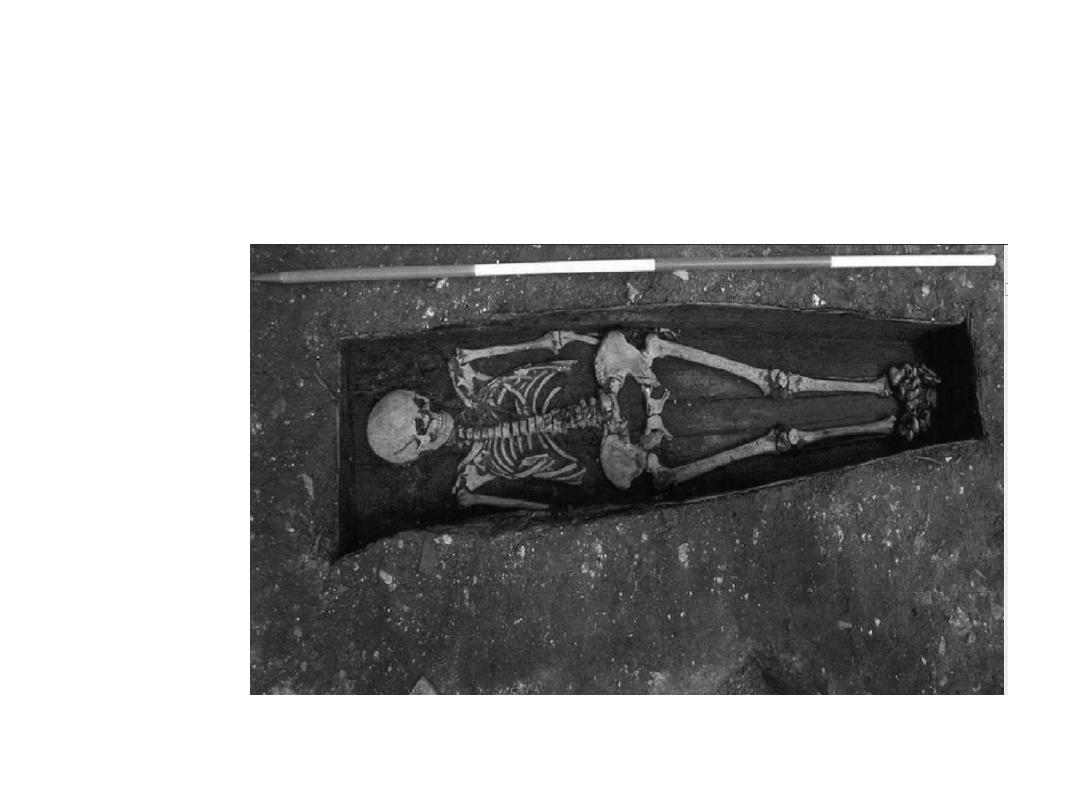
Old Disease
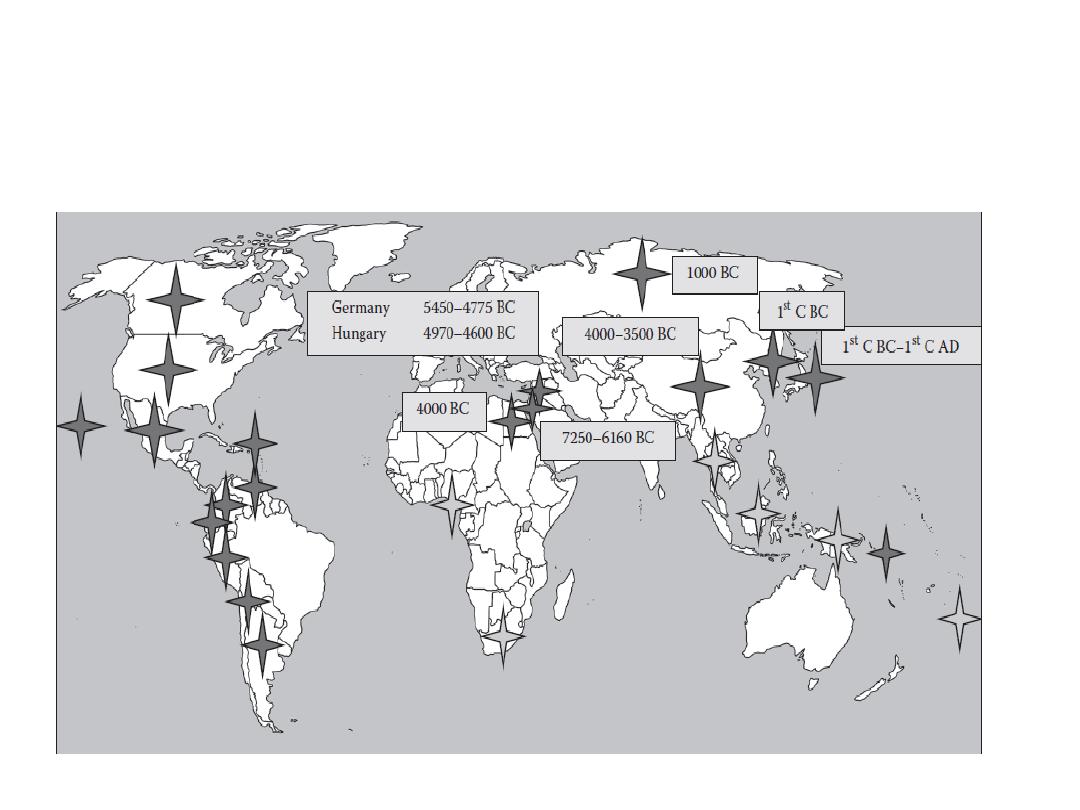
Oldest cases of T B

Epidemiology
• Tuberculosis (TB) is caused by infection with
Mycobacterium tuberculosis (MTB).
• In 2006
• there were an estimated 9.2 million new cases, 14.4
million prevalent cases and 1.5 million deaths attributable
to TB.
• around one-third of the world's population has latent TB.
• The majority of cases occur in the world's poorest nations.
• The resurgence of TB has been largely driven by HIV
disease and by lack of appropriate health care.

Iraq has a
• high burden of TB, the estimated incidence
was 45 per 100,000.
• Prevalence is 74 per 1 00 000.
• Mortality is 3 per 1 00 000.
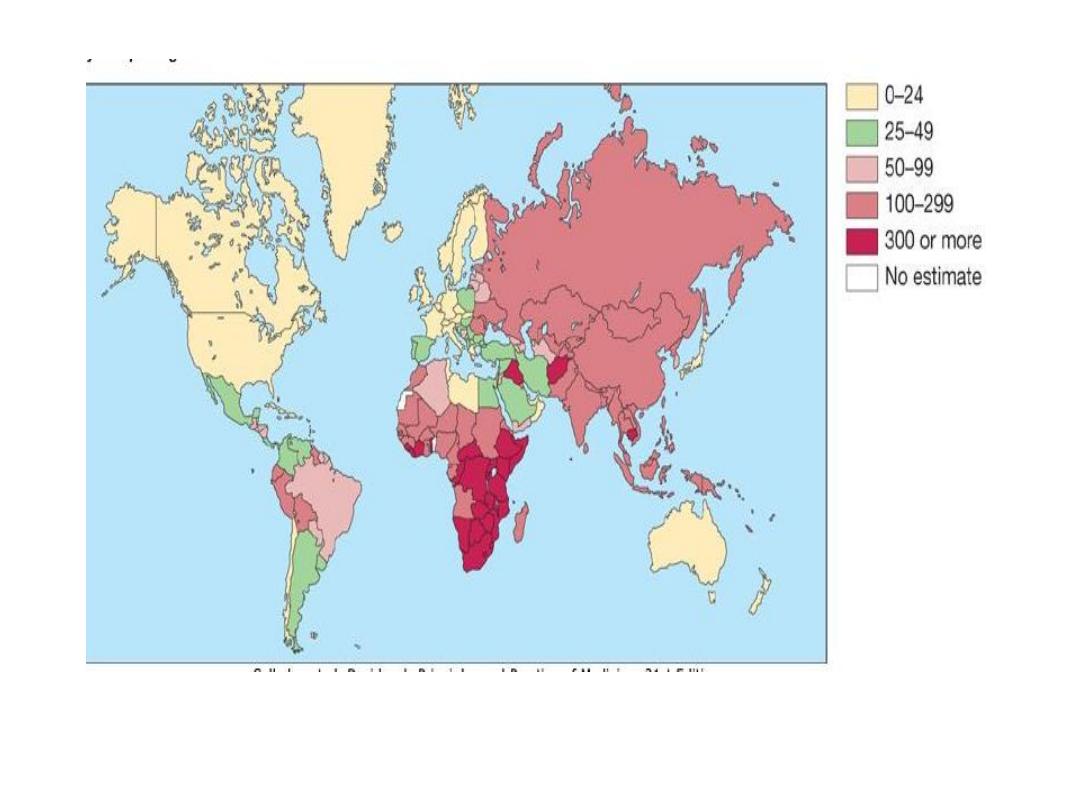
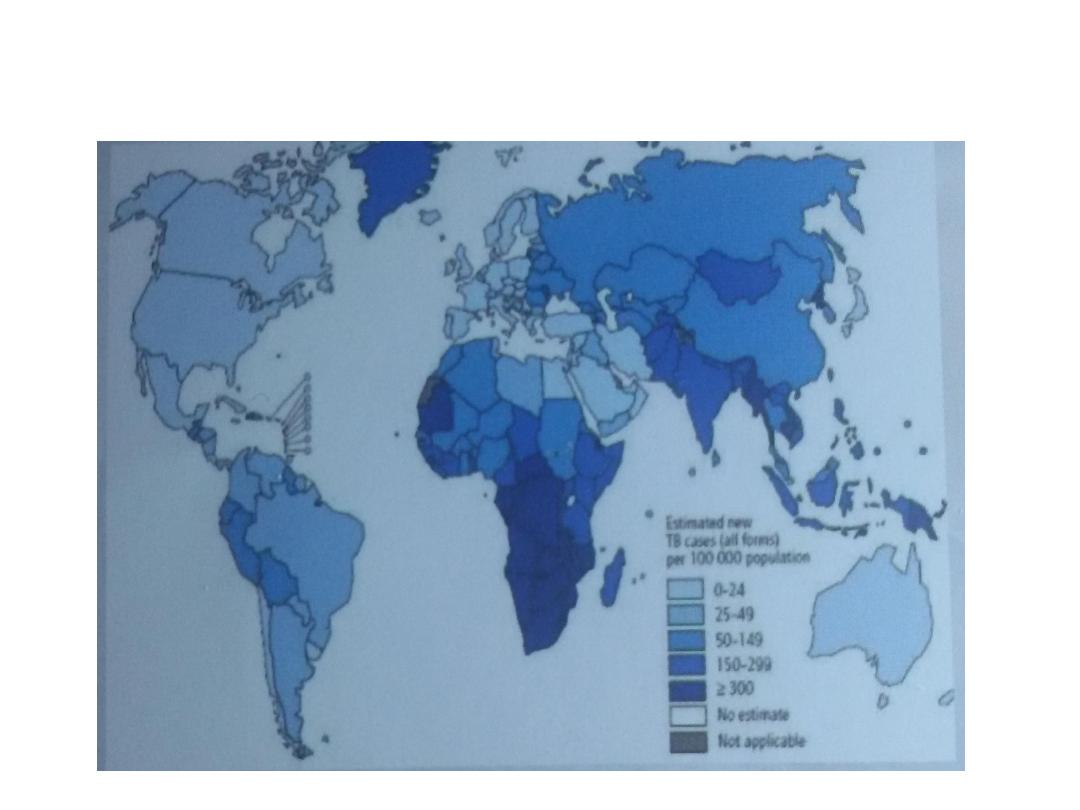
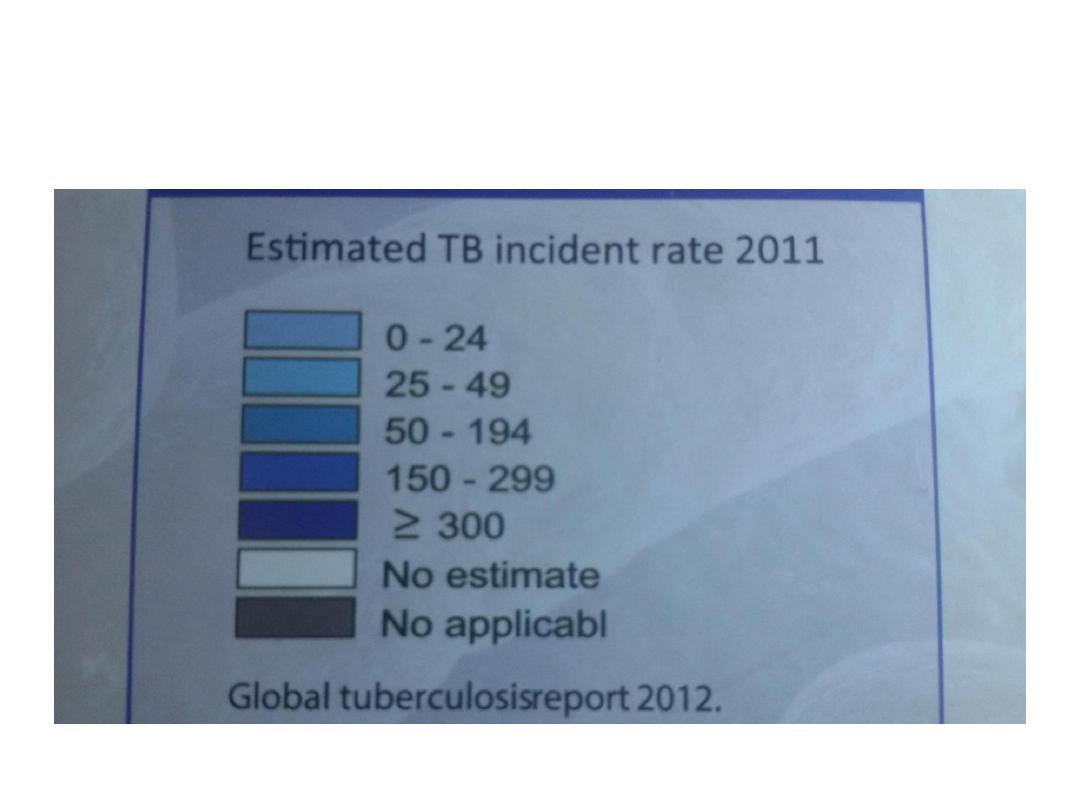

Flourescent stained microcolonies of M.tuberclonies .

Pathology and pathgenesis
• M. bovis infection arises from drinking non-
sterilized milk from infected cows.
• M. tuberculosis is spread by the inhalation of
aerosolised droplet nuclei from other infected
patients.

• Once inhaled, the organisms lodge in the
alveoli and initiate the recruitment of
macrophages and lymphocytes.
• Macrophages undergo transformation into
epithelioid and Langhans cells which
aggregate with the lymphocytes to form the
classical tuberculous granuloma .
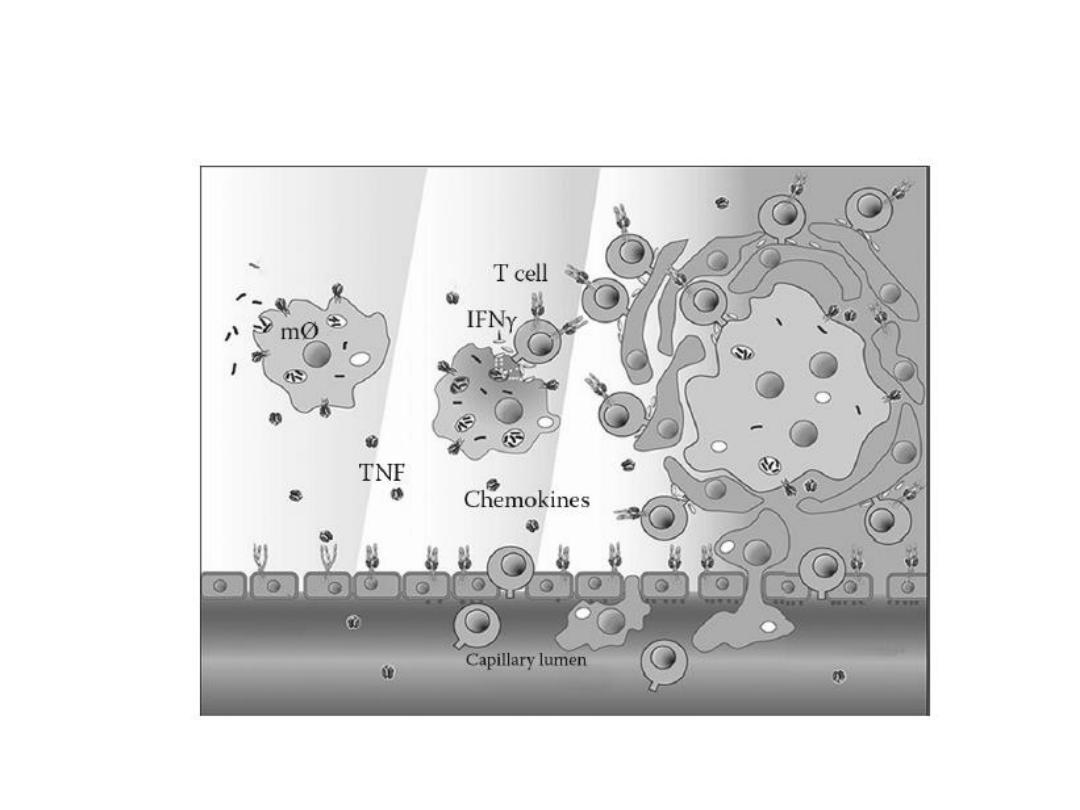
Granuloma formation in the lung. The central region of multinucleated giant cells, mycobacteria
and necrotic debris (right) is surrounded by concentric rings of tightly apposed epithelioid cells
and lymphocytes, with smaller numbers of neutrophils, plasma cells and fibroblasts.

Primary lesion or 'Ghon focus
Form from aggregation of numerous
granulomas which is situated in the periphery
of the lung.
‘Primary complex of Ranke
The combination of a primary lesion and
regional lymph nodes ( the hilar lymph nodes)
which has similar pathological reaction .

Latent TB
the primary complex in a fibrous capsule
limiting the spread of bacilli WHICH calcifies
and is seen on a chest X-ray.
Spread
lymphatic or haematogenous before immunity,
seeding secondary foci in other organs
including lymph nodes, serous membranes,
meninges, bones, liver, kidneys and lungs,
which may lie dormant for years.

What Tuberculin skin test ?
• The appearance of a cell-mediated, delayed-
type hypersensitivity reaction to tuberculin.
What happened if we inhale bacilli ?
• The estimated lifetime risk of developing
disease after primary infection is 5- 10%,
• half of this risk occurring in the first 2 years
after infection.

Electron microscopy show T.B bacilli

Granuloma
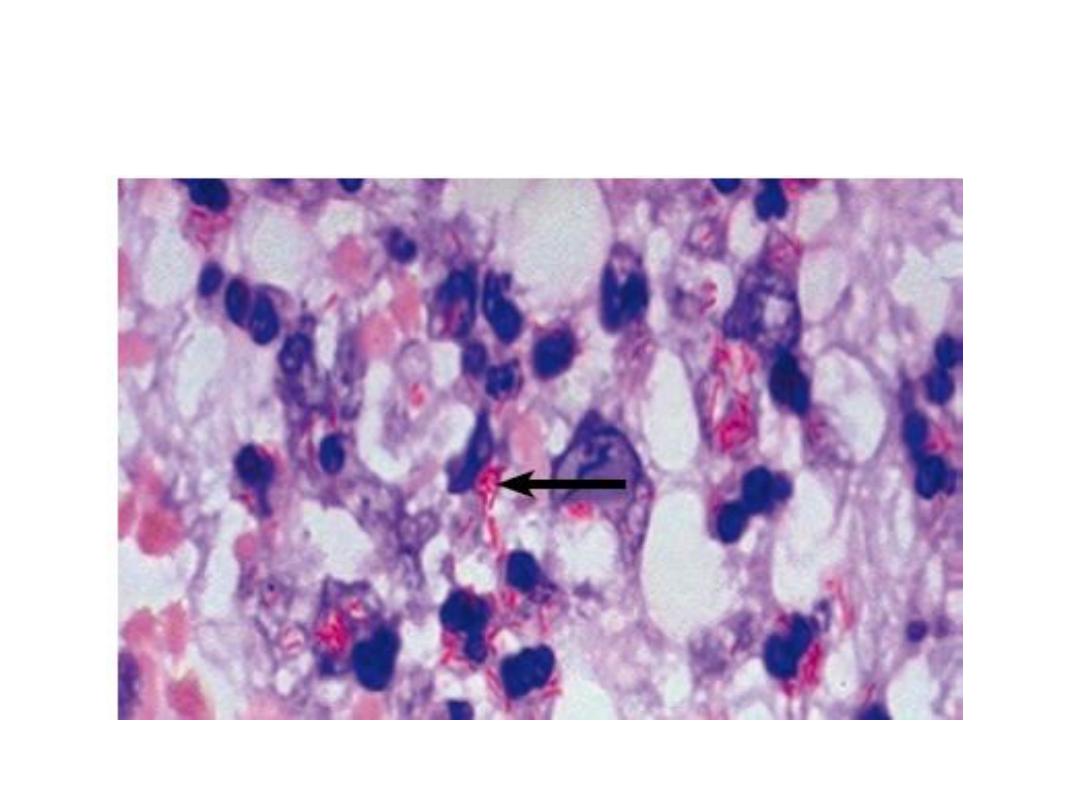
Positive Ziehl–Neelsen stain. Mycobacteria retain the red
carbol fuschin stain despite washing with acid and alcohol.

Diagram of the development of tuberculosis disease and its spread through
the body
.

Timetable of TB
Time from infection
Manifestations
• 3-8 weeks
Primary complex, positive
tuberculin skin test
• 3-6 months
Meningeal, miliary and pleural
disease
• Up to 3 years
Gastrointestinal, bone and
joint, and lymph node disease
• Around 8 years
Renal tract disease
• From 3 years onwards Post-primary disease
due to reactivation or reinfection

Pathogenesis of TB infection
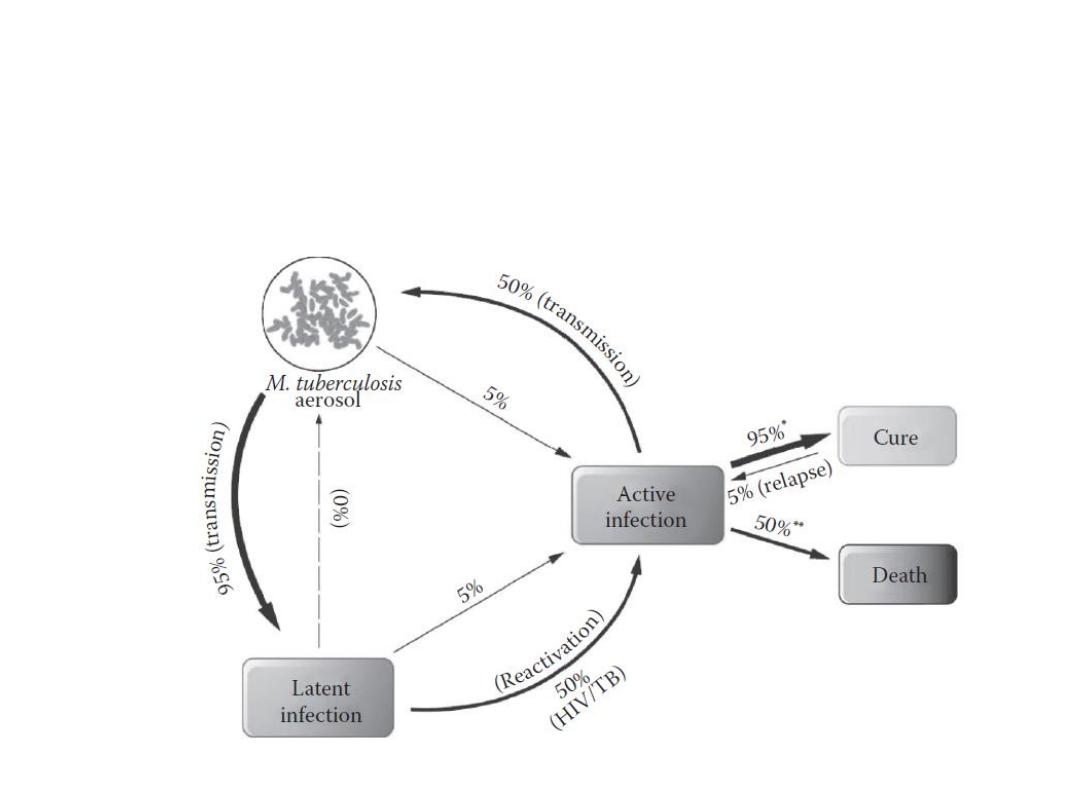
The answer
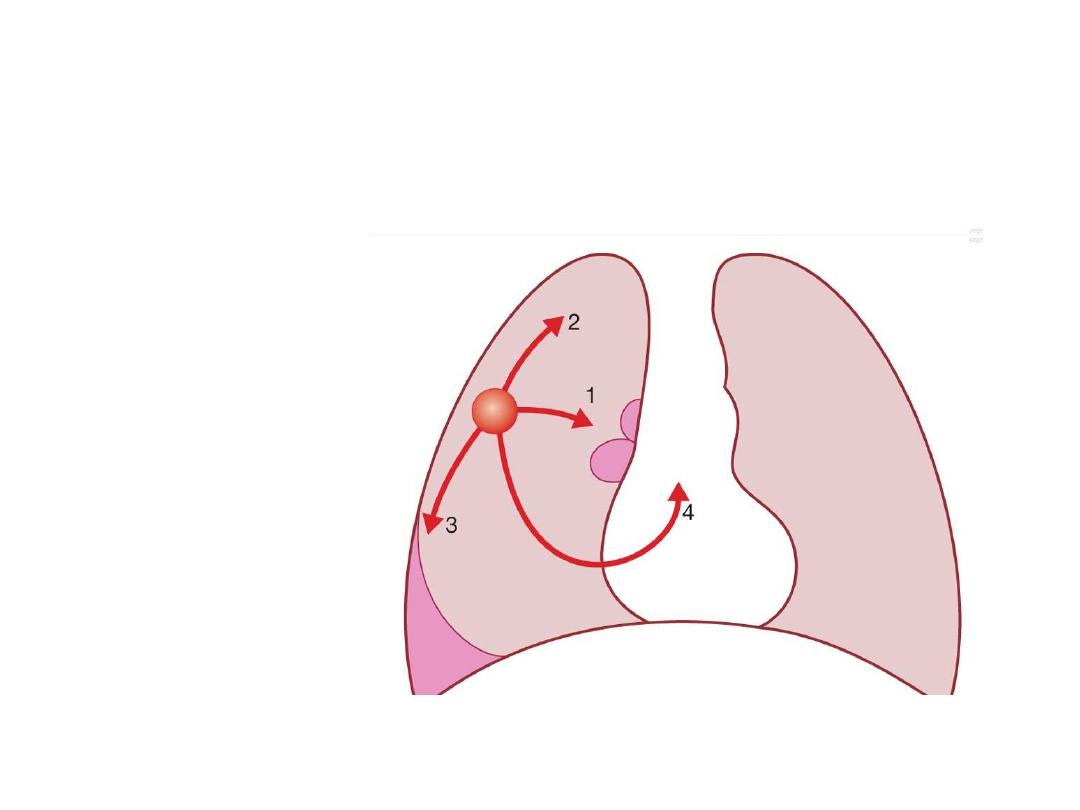
Primary pulmonary TB. (1) Spread from the primary focus to
hilar and mediastinal lymph glands to form the ‘primary complex’, which in
most cases heals spontaneously. (2) Direct extension of the primary focus—
progressive pulmonary TB. (3) Spread to the pleura—tuberculous pleurisy
and pleural effusion. (4) Blood-borne spread: few bacilli—pulmonary,
skeletal, renal, genitourinary infection often months or years later; massive
spread—miliary TB and meningitis.

Primary pulmonary TB.
• (1) Spread from the primary focus to hilar and
mediastinal lymph glands to form the 'primary
complex', which in most cases heals
spontaneously.
• (2) Direct extension of the primary focus-
progressive pulmonary TB.
• (3) Spread to the pleura-tuberculous pleurisy
and pleural effusion.
• (4) Blood-borne spread: few bacilli-pulmonary,
skeletal, renal, genitourinary infection often
months or years later; massive spread-miliary TB
and meningitis

Factors increasing the risk of TB
I--Patient-related
• Age (children > young adults < elderly)
• First-generation immigrants from high-prevalence
countries
• Close contacts of patients with smear-positive
pulmonary TB
• Overcrowding (prisons,); homelessness .
• Chest radiographic evidence of self-healed TB
• Primary infection < 1 year previously
• Smoking: cigarettes and bidis (indian cigarettes) .

II—Associated diseases
• Immunosuppression: HIV, anti-TNF therapy, high-
dose corticosteroids, cytotoxic agents.
• Malignancy (especially lymphoma and leukaemia)
• Type 1 diabetes mellitus
• Chronic renal failure
• Silicosis
• Gastrointestinal disease associated with
malnutrition
• Deficiency of vitamin D or A
• Recent measles.
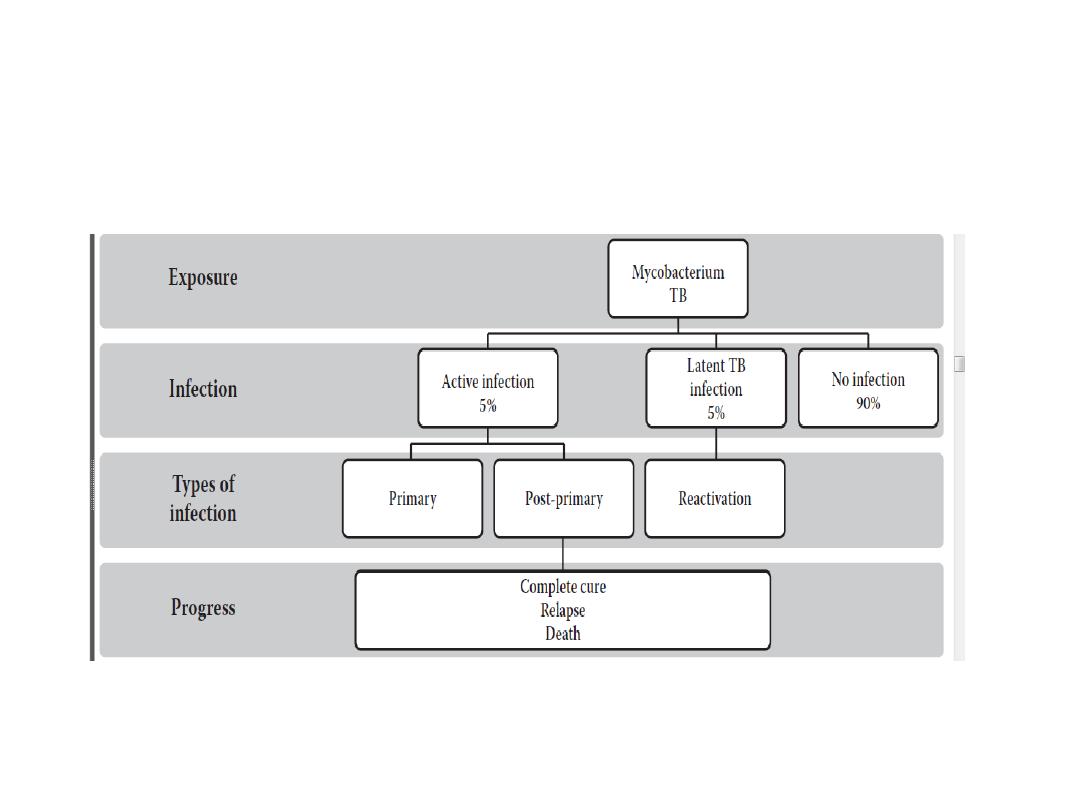
Pathogenesis and progress of T B

Clinical features:
• pulmonary disease
• Primary pulmonary TB.
• Post primary pulmonary T B.
• Miliary TB.
• Cryptic TB.

Features of primary TB
Infection (4-8 weeks)
•
Influenza-like illness
•
Skin test conversion
•
Primary complex

Features of primary TB
Disease
• Lymphadenopathy: hilar (often unilateral). paratracheal or mediastinal .
• Collapse (especially right middle lobe) .
• Consolidation (especially right middle lobe) .
• Obstructive emphysema .
• Pleural effusion .
• Endobronchial .
• Miliary .
• Meningitis.
• Pericarditis .
Hypersensitivity
• Erythema nodosum .
• Phlyctenular conjunctivitis .
• Dactylitis.
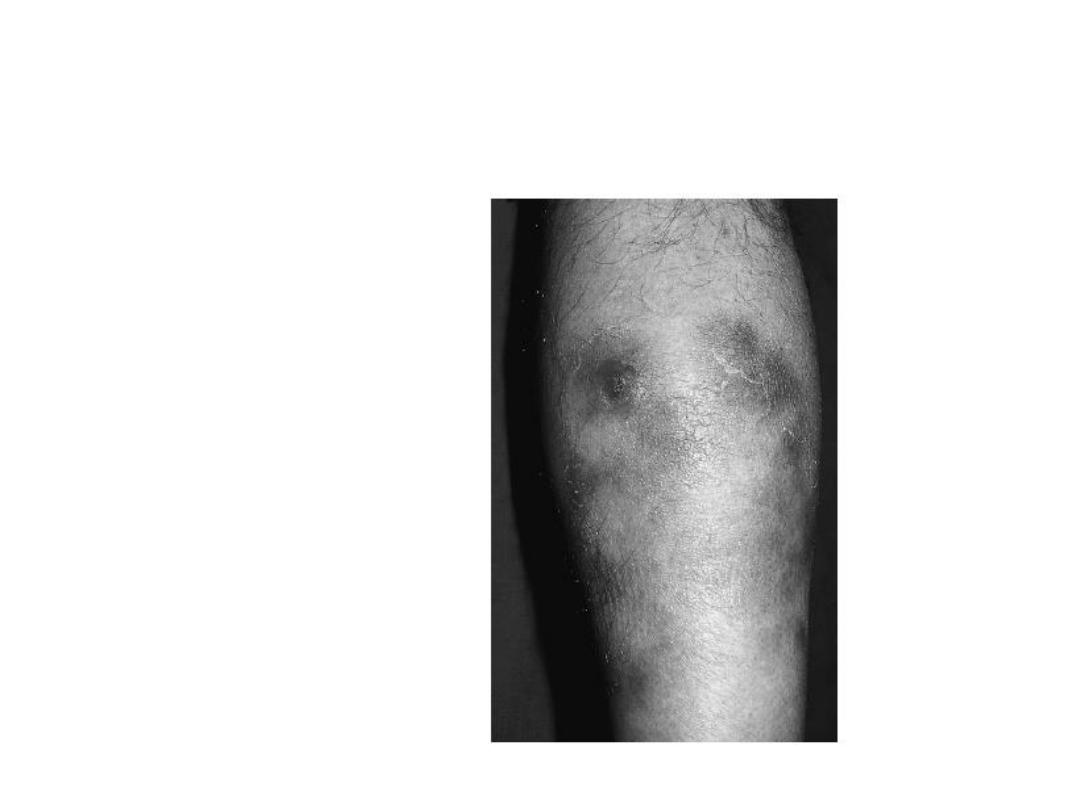
Erythema nodusum

Phlyctenullar conjuctivitis

Miliary TB
• Blood-borne dissemination
• acute
• 2-3 weeks of fever,
• night sweats,
• anorexia,
• weight loss
• dry cough.
• Hepatosplenomegaly
• headache may indicate tuberculous meningitis.
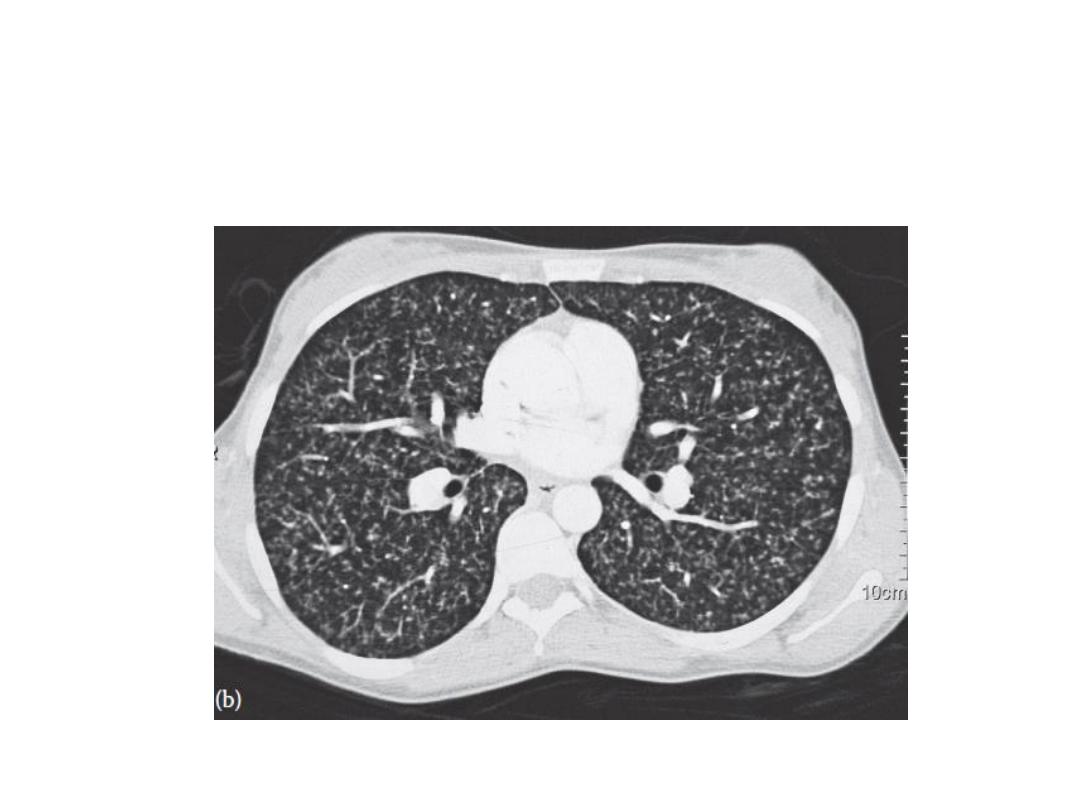
(a) Chest x-ray and (b) CT scan from a 27-year-old student with disseminated
tuberculosis . Multiple small opacities (miliary shadowing) are seen in the
periphery of the chest x-ray and much more clearly in all areas of the CT scan
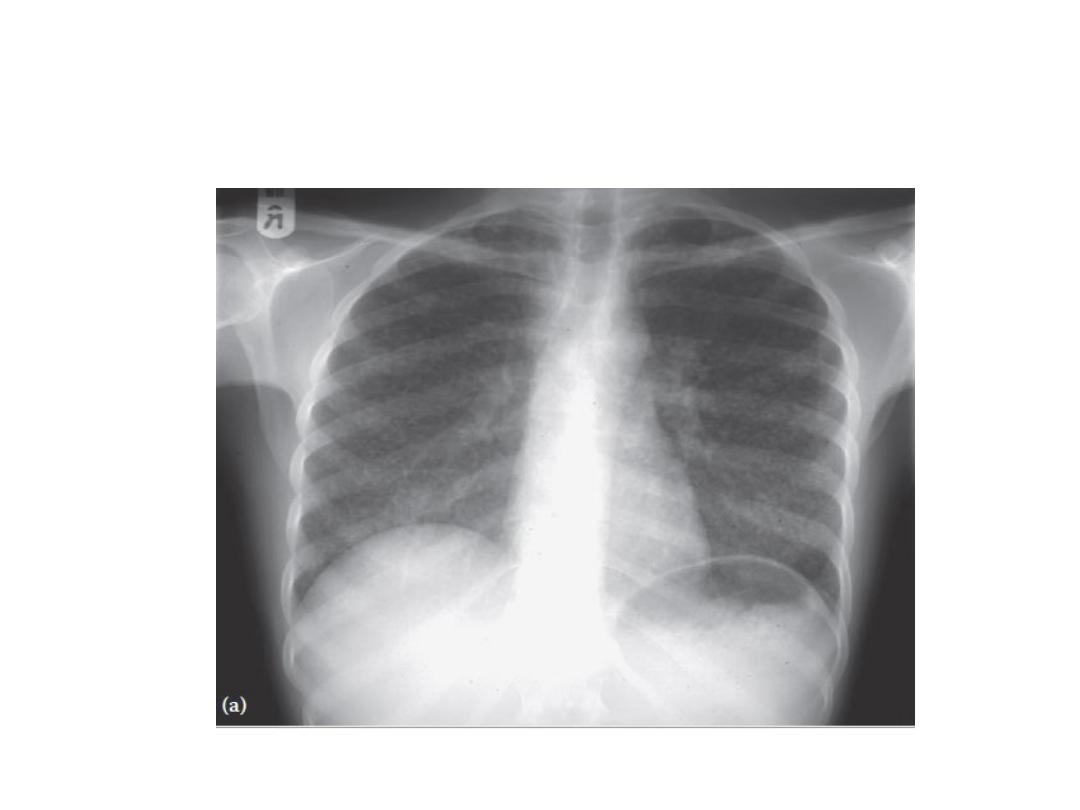
(a) Chest x-ray and (b) CT scan from a 27-year-old student with
disseminated tuberculosis . Multiple small opacities (miliary
shadowing) are seen in the periphery of the chest x-ray and much
more clearly in all areas of the CT scan

• Auscultation of the chest is frequently normal,
advanced disease crackles .
• Fundoscopy show choroidal tubercles.
• The classical appearances on chest X-ray are
of fine 1-2 mm lesions ('millet seed').
• Anaemia and leucopenia reflect bone marrow
involvement.

'Cryptic' miliary TB
• Age over 60 years
• Intermittent low-grade pyrexia of unknown origin
• Unexplained weight loss, general debility
(hepatosplenomegaly in 25-50%)
• Normal chest X-ray
• Blood dyscrasias; leukaemoid reaction, pancytopenia
• Negative tuberculin skin test
• Confirmation by biopsy (granulomas and/or acid-fast
bacilli demonstrated) of liver or bone marrow

Post-primary disease
Exogenous ('new' infection)
• Endogenous (reactivation of a dormant primary lesion)
• Lung apices .
• The onset insidious, slowly over several weeks.
Systemic symptoms
progressive
pulmonary symptoms .
Radiological changes
include
•
opacification in one or both of the upper lobes,
•
consolidation
•
collapse
• cavitation
• tuberculous pneumonia

Chronic complications of
pulmonary TB
Pulmonary
• Massive haemoptysis
• Cor pulmonale
• Fibrosis/emphysema
• Atypical mycobacterial infection
• Aspergilloma
• Lung/pleural calcification
• Obstructive airways disease
• Bronchiectasis .
• Bronchopleural fistula

Case
• Radiological investigation of a 78-year-old man with a
six-week history of productive cough, fever, left-sided
chest pain, dyspnoea on exertion and hoarse voice . (a)
Chest x-ray and (b) CT scan showed (c) a soft tissue
mass in the left upper lobe that encased the left upper
lobe bronchus. (d) A chest x-ray performed at the end
of TB treatment showed a significant resolution of the
initial consolidation seen in the left upper lobe,
persistence of the mass (diagnosed as being carcinoid
tumour), left upper lobe fibrosis, loss of left lung
volume, a left pleural effusion and a large heart
shadow

.
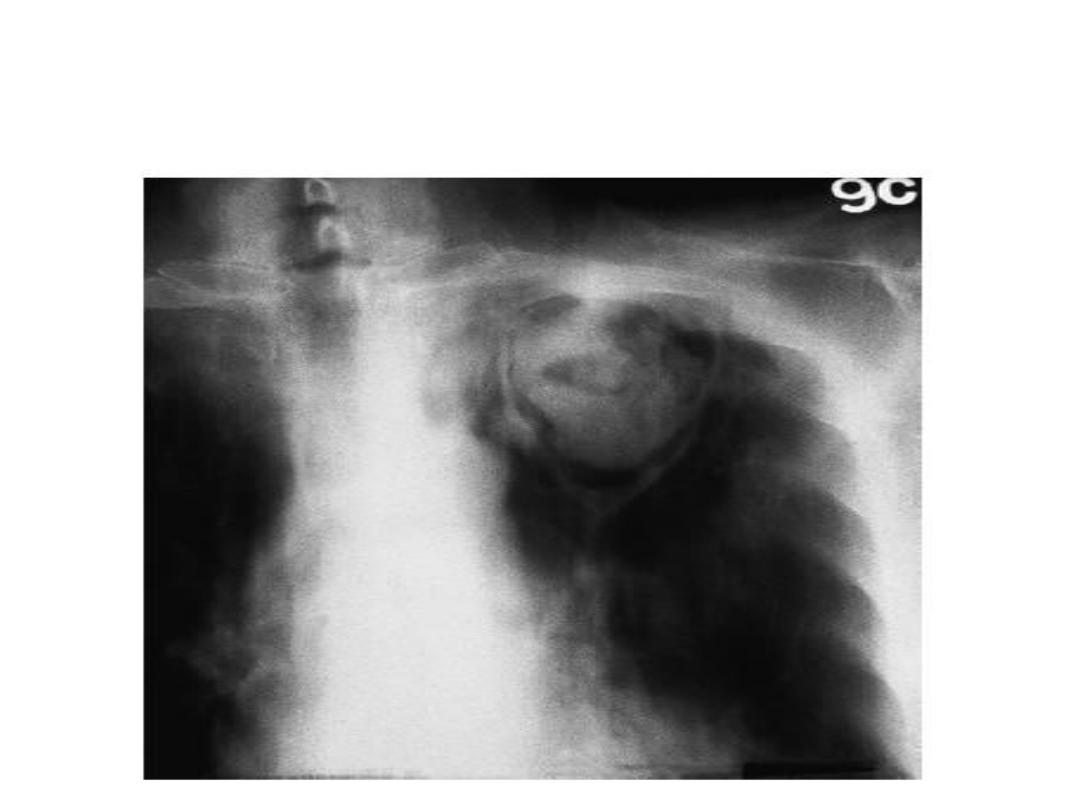
Posteroanterior chest x-ray showing an
aspergilloma in the left apex.

Non-pulmonary complication
• Empyema necessitans
• Laryngitis
• Enteritis.
• Anorectal disease .
• Amyloidosis.
• Poncet's polyarthritis

Diagnosis of TB
• Specimens required
Pulmonary
• Sputum (induced with nebulised hypertonic saline if not
expectorating)
• Bronchoscopy with washings or BAL
• Gastric washing (mainly used for children)
Extrapulmonary
• Fluid examination (cerebrospinal, ascitic, pleural,
pericardial, joint): yield classically very low
• Tissue biopsy (from affected site); also bone marrow/liver
may be diagnostic in patients with disseminated disease


• Diagnostic tests
• Circumstantial (ESR, CRP, anaemia etc.)
• Tuberculin skin test (low sensitivity/specificity;
useful only in primary or deep-seated infection)
• Stain
– Ziehl-Neelsen
– Auramine fluorescence
• Nucleic acid amplification
• Culture
– Solid media (Löwenstein-Jensen, Middlebrook)
– Liquid media (e.g. BACTEC or MGIT)
• Response to empirical antituberculous drugs
(usually seen after 5-10 days)

Sputum AFB positive

T B bacilli

• Skin testing in TB:
• tests using purified protein derivative (PPD)
• Heaf test
• Mantoux test
• Results may be:
• False negatives
• false-positive
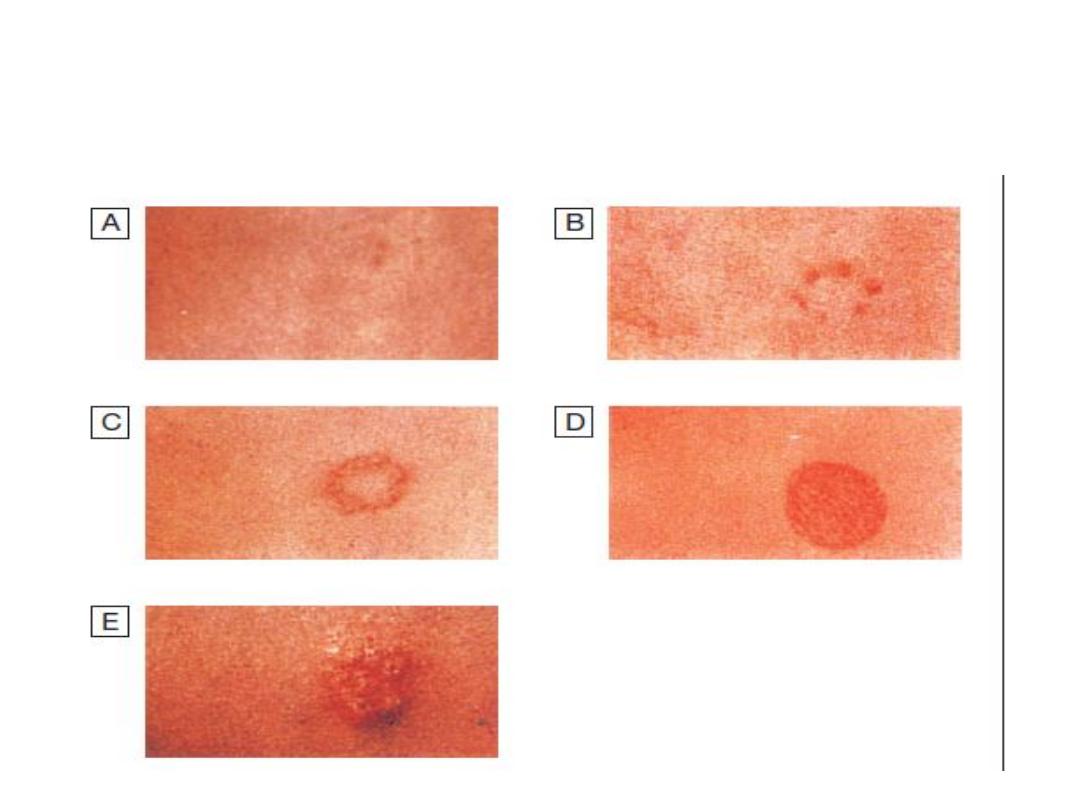
Gradings of the Heaf test response. A Negative.
B Grade 1. C Grade 2. D Grade 3. E Grade 4.

Chest Xray TB
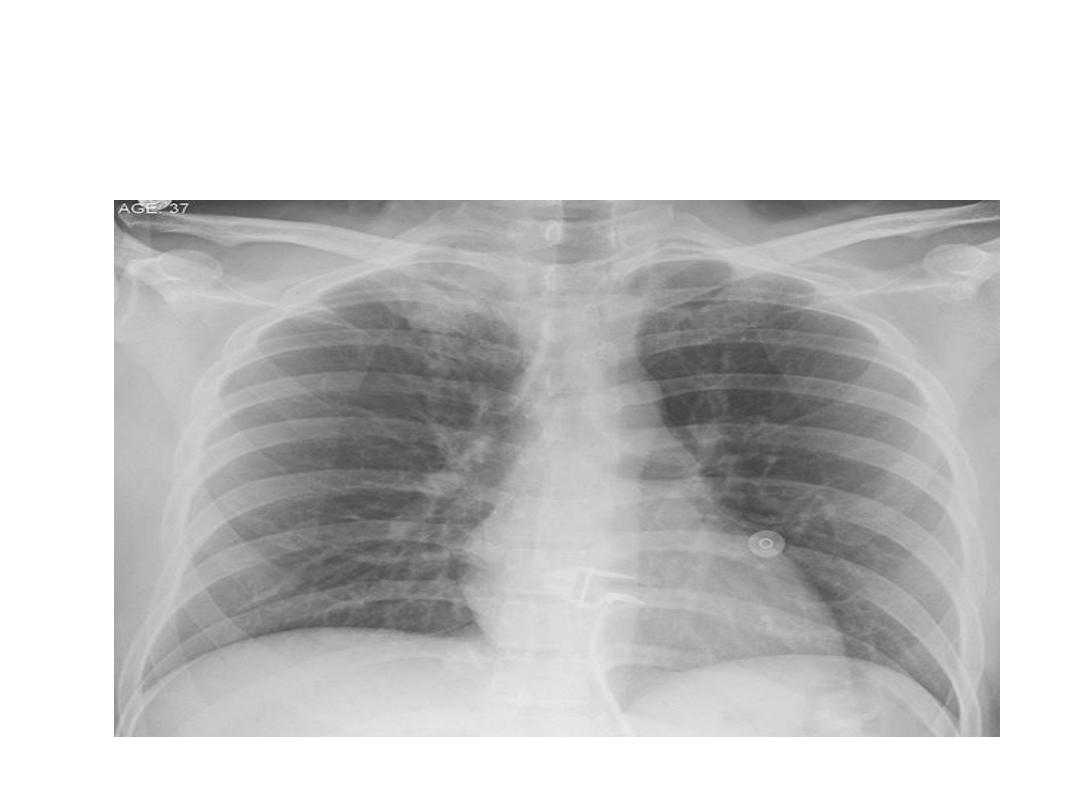
Chest Xray
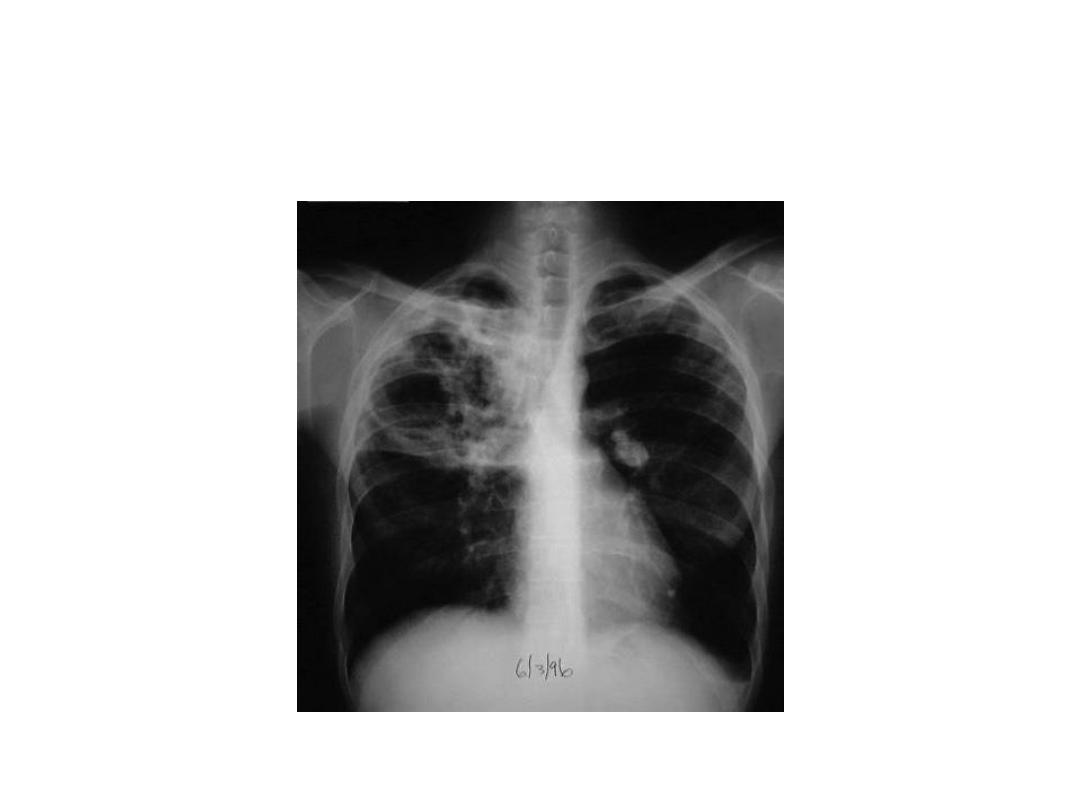
Chest Xray
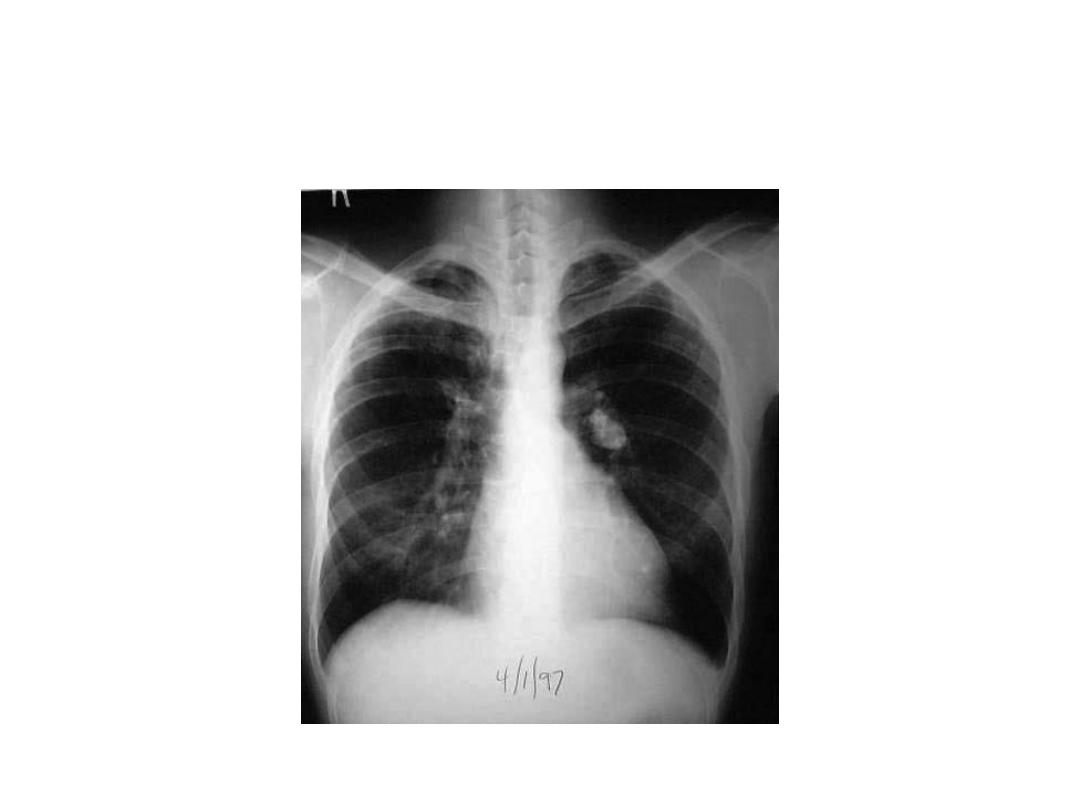
Chest Xray
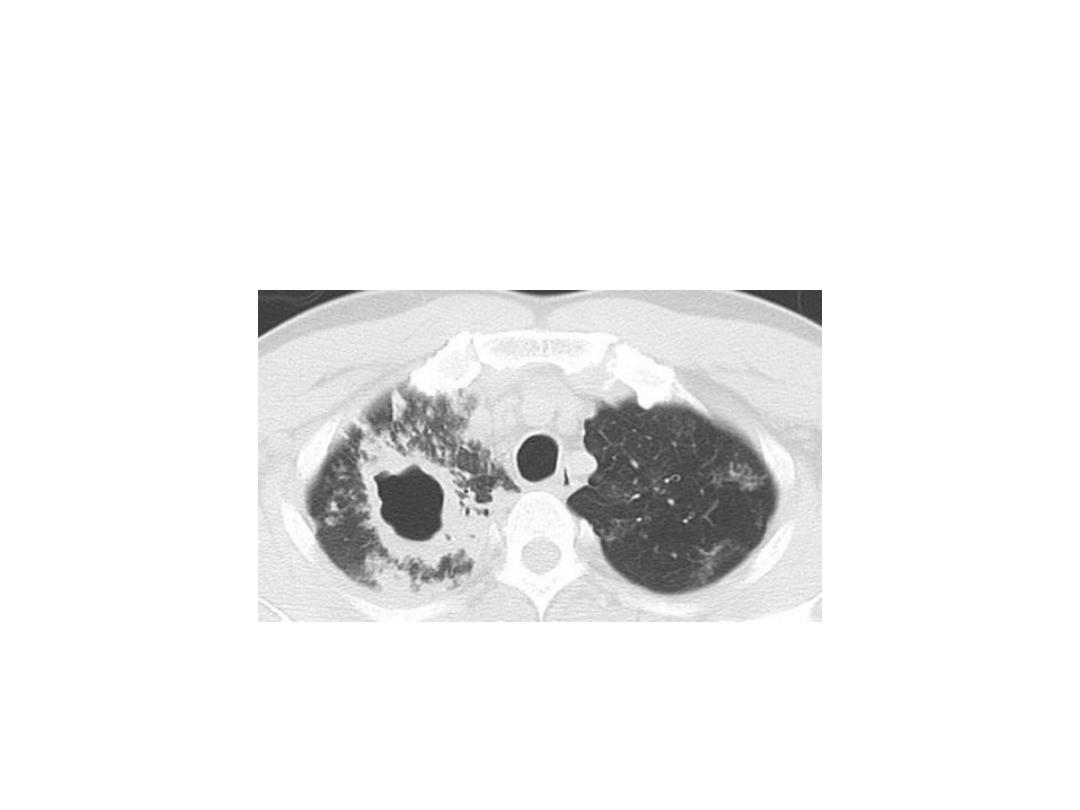
CT Chest
pulmonary TB show cavitation

Other TEST FOR PULMONARY TB
• Interferon-gamma release assays (IGRAs).
• culture filtrate protein (CFP)-10..
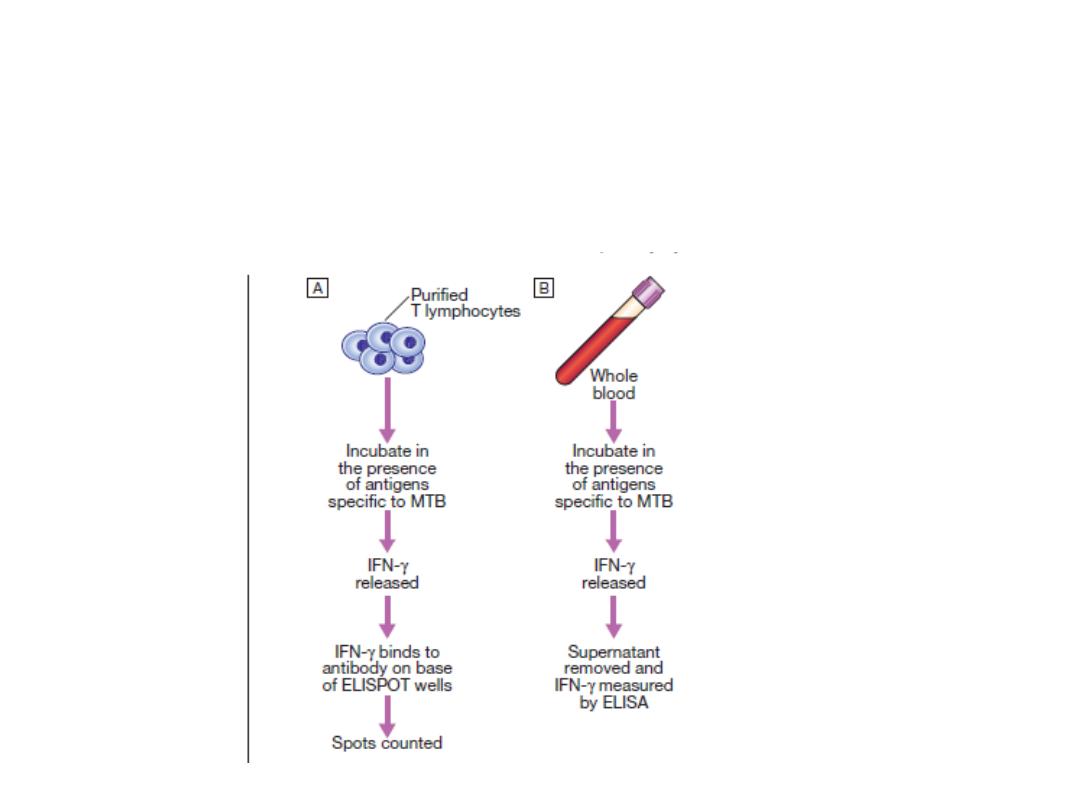
The principles of interferon-gamma
release assays.

• Chemotherapy
Indication:
• Patient who is smear-positive,
• smear-negative but with typical chest X-ray changes.
Quadruple therapy has become standard
• Fixed-dose tablets combining two or three drugs are
generally favoured:
• (rifampicin, isoniazid and pyrazinamide) daily for 2
months(initial phase)
• (rifampicin and isoniazid) daily for 4
months(continous phase) .

Duration of treatment
• Six months of therapy
•
all patients with new-onset, uncomplicated
pulmonary disease.
• 9-12 months of therapy
• HIV-positive
• drug intolerance
• 12 months
•
Meningitis
Added to treatment Pyridoxine
• pregnant women
• malnourished patients.
• Where drug resistance is not anticipated, patients can
be assumed to be non-infectious after 2 weeks of
appropriate therapy.

Admission to a hospital unit if :
• Uncertainty about the diagnosis.
• Intolerance of medication.
• Questionable compliance.
• adverse social conditions .
• a significant risk of multidrug-resistant TB
(MDR-TB: culture-positive after 2 months on
treatment, or contact with known MDR-TB).

• Recommendations in treatment
• Do baseline liver function and regular monitoring.
• Adverse drug reactions occur in about 10% of
patients.
• Corticosteroids reduce inflammation
• Surgery is still occasionally required but usually only
after a full course of antituberculosis treatment.
• A positive sputum smear at 5 months defines
treatment failure

• Control and prevention
• 1-detection of latent TB
• 2- treatment of active and latent TB
.
Detection of latent TB
• Contact tracing .
• Probable index case.
• Close contacts who should receive BCG vaccination or
chemotherapy.
• Rifampicin plus isoniazid for 3 months or isoniazid for
6 months is effective.
Vaccines
• BCG (the Calmette-Guérin bacillus), a live attenuated
vaccine,. BCG appears to be effective in preventing
disseminated disease

• Directly observed therapy (DOT)
• Poor adherence to therapy is a major factor in:
• prolonged infectious illness
• risk of relapse
• the emergence of drug resistance.
• Recommended
• unlikely to be adherent to therapy
• homeless,
• alcohol
• drug users
• serious mental illness
• non-compliance

• TB and HIV/AIDS
• It is recommended that all patients with TB
should be counselled and tested for HIV
disease.
• Mortality is high and TB is a leading cause of
death in HIV patients.

• Drug-resistant TB
• defined by the presence of resistance to any
first-line agent.
• Multidrug-resistant (MDR) TB.
• Extensively drug-resistant (XDR).
• Diagnosis is challenging

• Prognosis
• Following successful completion of
chemotherapy, cure should be anticipated in
the majority of patients.
• A small risk of relapse.

Thank u

Q
QIUZE
